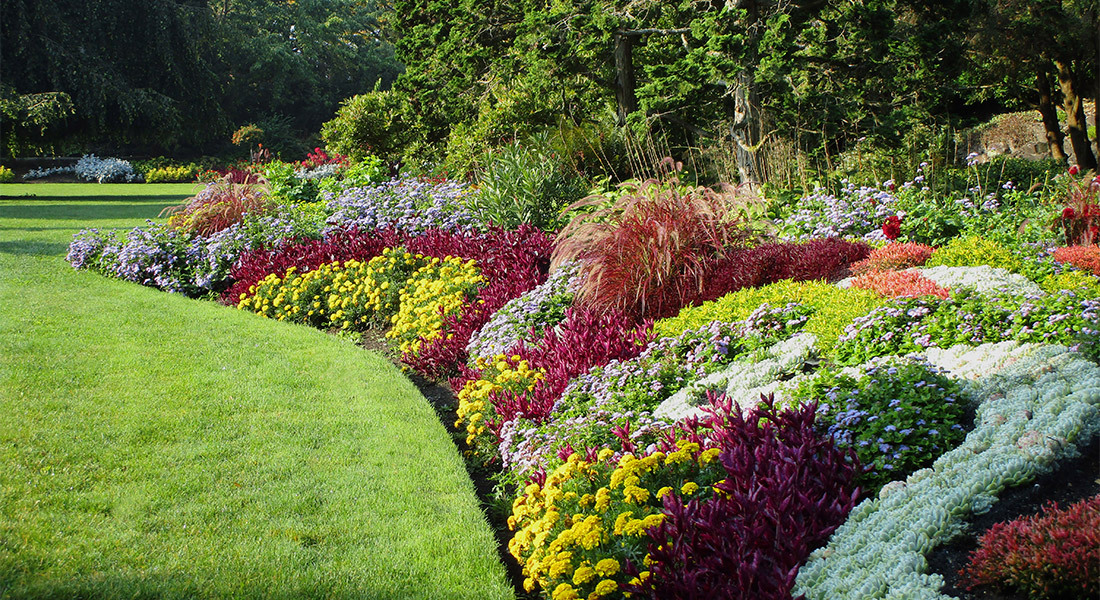What suggestions do you have for flower bed design?

The design for flower beds is limited only by your imagination. This can be a good thing (time to get creative!) or it can seem overwhelming (where do I even begin?). A good first step is to figure out what you want to get out of the space. Are you looking to attract pollinators to your yard? Do you want to go all-in with native plants? Is there a specific color scheme you’re hoping to achieve? Or maybe you want to have a seasonal supply of cut flowers to fill your home with bouquets? Having a clear idea of the end goal can help you create the garden you really want. To help jump-start your flower beds, here are ten great idea starters.
- Plant fragrant flowers — Few things are as peaceful and pleasing as a walk through a garden filled with fragrant blooms. Plants like alyssum, freesia, gardenia, jasmine, lilac, lilies, magnolia, mock orange, phlox, rose and sweet pea not only look amazing, they smell wonderful too.
- Go wild with wildflowers — Sometimes the nicest planned flower garden doesn’t look like it was planned at all. Wildflowers bring a natural look to any flower bed with a vibrant array of colors, heights and textures. Once planted, a wildflower bed is a low-maintenance and low-water garden. And they’re a natural draw for birds and pollinators.
- Create an herb garden — Planting an herb garden offers a variety of benefits, since herbs are edible, aromatic and beautiful. Experiment with mixing flowering herbs, like chamomile, lavender and sage, with culinary herbs, such as basil, rosemary and thyme. Not only will you have fresh ingredients on hand for cooking, you’ll also attract pollinators to your yard.
- Get creative with color — Another approach is to fill your garden beds with colorful flowers that are known for the showy blooms, such as butterfly weed, dahlias, false indigo, hydrangeas, mandavilla, nasturtium and zinnias — the more color, the better. Another way to approach this is to pick a single color or two and use plants that flower with different shades of those colors, creating more of an ombre effect.
- Experiment with height— It’s easy to create dimension in your flower beds by growing blooms of various heights. To do so, you first need to figure out how tall each type of flower will become when in full bloom. Put taller flowers in the back — like allium, coneflower, daylily, delphinium, fairy candle, foxglove, hollyhock, lupine, red-hot poker, Russian sage and salvia. Then work your way to the front using medium-sized flowering plants, with dwarf florals up front. This is a great way to give each bloom a chance to shine.
- Invite pollinators to the party — Pollinator-friendly plants are gorgeous, often smell great, and welcome pollinators like bees, butterflies and hummingbirds to your garden. They also contribute to the overall health of your backyard ecosystem. Try using plants like asters, bee balm, blue star, butterfly bush, columbine, Joe Pye weed and penstemon. Consider adding a bird bath to the mix as well.
- Fill your beds with native flowers — It’s likely that you’ve read a story or two about problems related to non-native, or invasive, species — plants that aren’t from our part of the country, so they tend to take over an area and overpower other plants. The antidote to that is native plants — plants that occur naturally in our region. Native plants have evolved and adapted to the soils and climates of the area and Oregon include beardtongues, bleeding heart, columbine, fleabane, iris, larkspur, lupine, Nootka rose, redwood sorrel, spirea, thimbleberry and woods’ rose, to name a few.
- Build a border garden — Bordering your lawn or framing your landscape with a flower bed is a great way to create a seamless transition between different areas of your yard. Along with defining boundaries, they can also help prevent soil erosion and provide a habitat for beneficial insects.
- Plan for a full year of flowers — This one takes a little bit more work upfront, but it’s possible to create a flower bed that thrives in all four seasons. When developing the bed, do so in a way that includes flowers that bloom in spring, summer, fall and winter, then spread the plants out accordingly and watch the magic happen. See what works, what doesn’t work and adjust accordingly. Then with routine maintenance and watering, you should be able to enjoy seasonal flowers year-round.
- Design a drought-resistant bed — It’s no surprise that temperatures have long been on the rise. You can see that reflected in plants that at one time required more tropical zones for growth that can now be grown here. Warmer temperatures mean increased watering too, which can be time-consuming and rack up a higher water bill. One solution is to plant drought-tolerant flowers in your beds. Compared to other plants, drought-resistant perennials — like coreopsis, echinacea, hibiscus, lavender, salvia, scabiosa, Shasta daisy and wisteria — require minimal maintenance, making upkeep easier. And don’t forget the Rogue Fine Compost — it’s a great way to help keep moisture in the soil to help your plants thrive, even when it’s dry out.
Share This
